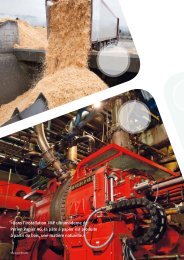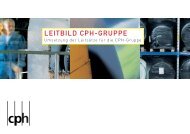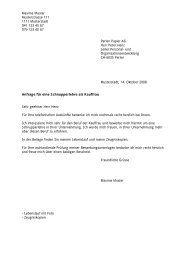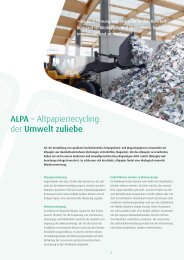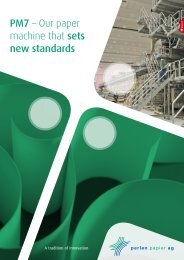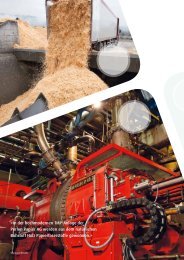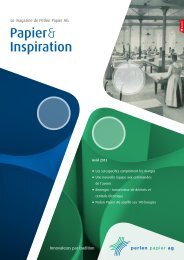Perlen adds a new twist! - Perlen Papier AG
Perlen adds a new twist! - Perlen Papier AG
Perlen adds a new twist! - Perlen Papier AG
You also want an ePaper? Increase the reach of your titles
YUMPU automatically turns print PDFs into web optimized ePapers that Google loves.
TMP: Complete Technology for Good Paper.<br />
<strong>Perlen</strong> <strong>adds</strong> a <strong>new</strong> <strong>twist</strong>!<br />
A tradition we keep very much alive.
High-Tech TMP Plant<br />
The TMP plant at <strong>Perlen</strong> represents in all respects today’s state-of-the-art<br />
technology and contains a variety of technical and technological developments<br />
that are all targeted to increase the efficiency of the system, to optimize<br />
production cost – especially energy cost, and at the same time to<br />
obtain an optimum pulp quality for the very demanding production program<br />
of <strong>Perlen</strong>. As raw material chips from saw mill waste and forest thinnings<br />
are used which are wet cleaned and conditioned at a temperature of approx.<br />
85°C. The heart of the thermomechanical pulp production is the big refiner<br />
which refines the chips fully automated to fiber material for paper production.<br />
This Andritz pressurized refiner model TC 66 was installed for the first<br />
time worldwide as a <strong>new</strong> development in the production in the year 1994.<br />
This machine operates at a higher speed and therefore allows an energetically<br />
more efficient refining process which results in reduced energy consumption.<br />
All refining is accomplished under pressure, so that a major portion<br />
of the heat losses is collected in the form of steam which is used at the<br />
drying sections of the paper machines.<br />
The RTS (R = retention time, T = temperature, S = speed) process, developed<br />
by Andritz in Springfield, Ohio, was the first time realized at <strong>Perlen</strong> in the<br />
year 1996. At this process the chips are heated for a very short time at the<br />
feed to the refiner and thereafter defiberized at high speed. At the high temperature<br />
(up to 180°C) the lumen of the chips is heated and the secondary<br />
fiber walls are softened. This results in a reduced breakage of fibers at defiberizing<br />
leading to better strength properties. This short time (10–12s)<br />
avoids coloring and therefore loss in brightness. The fibers mechanically<br />
treated in the refiner are strongly curled. This tension (latency) is removed<br />
through intense agitation in the latency chest at about 85°C. The following<br />
pressurized screening eliminates shives and fiber bundles. The screening is<br />
effected at a consistency of more than 3%.<br />
The applied screen baskets have a slot width of 0.15mm only. The shives<br />
and fiber bundles have to be processed in a further refining stage. After<br />
dewatering to a high consistency, this refining is accomplished in a reject<br />
refiner model SB 150. After separation of steam thereby produced, the fiber<br />
material is blown to the latency chest and mixed with the pulp from main<br />
refining.<br />
In order to comply with all requirements of the variety of paper grades in the<br />
production program of <strong>Perlen</strong>, the pulp is thereafter individually bleached. To<br />
increase the reaction efficiency with the bleaching agents, the pulp is dewatered<br />
between two synthetic sieves. For papers with lower brightness the<br />
pulp is brightened in medium consistency hydrosulfite bleaching. In a second<br />
line thickening is accomplished to approx. 45% by means of a double-wire<br />
press. In a high-consistency mixer hydroperoxide is added to obtain the required<br />
brightness after the bleaching tower. After hydroperoxide bleaching,<br />
the TMP is washed in a screw press. Thereby not fully integrated hydroperoxide<br />
is recycled into the TMP process. The plant is equipped with a modern<br />
process control system and fully automated quality and control facilities. At<br />
various points within the process pulp samples are drawn on a regular basis<br />
and sent to a central control station (Pulp Expert). The measurements are<br />
fully automatic and serve the operator to maintain the quality requirements.<br />
The average capacity of the plant is 350 tons/day of finished pulp and can<br />
be increased to 380tons/day.
TMP – an important paper fiber<br />
raw material<br />
27<br />
12<br />
1<br />
5<br />
6<br />
10<br />
15<br />
20<br />
21<br />
23<br />
3<br />
2<br />
4<br />
7 13<br />
14<br />
8<br />
9<br />
11<br />
18<br />
17<br />
16 19<br />
22<br />
24<br />
25<br />
26<br />
TMP (Thermo Mechanical Pulp) is the most important and worldwide widely<br />
used process to produce paper fiber material from wood. The raw material<br />
exclusively consists of chips from saw mills (saw mill waste) and chips from<br />
forest thinnings.<br />
Quality of TMP<br />
The quality of the produced TMP is a direct function of the applied energy and<br />
the quality (freshness) of the used wood. Thanks to modern technology the<br />
energy consumption in <strong>Perlen</strong> could be drastically reduced without changing the<br />
decisive quality advantages of TMP. The TMP fiber pulp distinguishes itself<br />
through various positive quality criteria.<br />
High Volume<br />
The higher volume of the TMP pulp compensates the loss of bulk from deinked<br />
waste paper. For <strong>new</strong>sprint production the higher volume minimizes the ink<br />
penetration and increases the paper stiffness.<br />
Improved moisture uptake<br />
The TMP pulp provides improved compressibility of the paper and therefore<br />
facilitates ink uptake.<br />
Higher Brightness<br />
For improved <strong>new</strong>sprint papers as well as for LWC papers (light-weight coated<br />
papers) the pulp can economically be bleached to the higher brightness level by<br />
adding peroxide.
“TMP: a high quality paper fiber made from natural wood.“<br />
1<br />
2<br />
Chip Washing<br />
The chips are cleaned from fines and<br />
impurities. Since the washing process<br />
is accomplished at a temperature of<br />
85°C, the chips are simultaneously<br />
heated and conditioned.<br />
Presteaming Bin<br />
The chip mixture of saw mill waste<br />
and chips from forest thinnings are<br />
fed to the preheating bin.<br />
Chip Washer<br />
The chip washer removes tramp material<br />
such as sand, stones and metal<br />
particles as well as knots. From the<br />
washer the chips are pumped via a<br />
cyclone to drain screw.<br />
3<br />
4<br />
5<br />
6<br />
Tramp Removal Conveyor<br />
This dewatering screw separates<br />
impurities from the washwater.<br />
Cyclone<br />
A hydrocyclone separates remaining<br />
foreign particles and sand.<br />
Dewatering Screw<br />
After the cleaning process (washing)<br />
the chips are separated from the<br />
washwater.<br />
Presteaming Bin<br />
Washed and to 85°C preheated chips<br />
are interim stored at the presteaming<br />
bin.<br />
7<br />
Main Refining<br />
The heart of a modern TMP plant is<br />
the main refining unit (refiner 7). The<br />
chips are defiberized and refined between<br />
rotating refining plates. The<br />
heat generated during this process<br />
evaporates excess water, and the<br />
steam is led to the heat recovery<br />
system.<br />
Main Refining (Refiner TC 66)<br />
The plug screw feeder after the presteaming<br />
bin squeezes the chips into<br />
the pressurized area of the refiner. By<br />
heating the chips for a short, controlled<br />
while to above 150°C, these are<br />
strongly softened without, however,<br />
coloring. The refining as such is effected<br />
between two rotating discs. A<br />
high energy input is required to loosen<br />
8<br />
9<br />
the fiber bond respectively to accomplish<br />
fiber separation and treatment.<br />
A large part of the applied energy is<br />
transformed when the chips' humidity<br />
is evaporated.<br />
Pressurized Cyclone (Steam<br />
Separator)<br />
Together with the steam the fibers<br />
are blown from the refiner to the<br />
pressurized cyclone where steam and<br />
fibers are separated. The steam is led<br />
to the heat recovery system and the<br />
pulp is discharged into the latency<br />
chest.<br />
Latency Chest<br />
The mechanically pretreated fibers are<br />
strongly curled. This tension (so-called<br />
“latency“) is removed by intensive agi-
“Papers with extraordinary quality properties are based on perfect raw<br />
materials (pulp).“<br />
10<br />
tation and pumping at about 85°C to<br />
obtain maximum fiber flexibility.<br />
Screening<br />
Fiber bundles that are not yet completely<br />
loosened are separated.<br />
Screening System<br />
Fibers that are not yet completely refined<br />
are separated in the screening<br />
(consistency 3–4%). The accepted<br />
fibers (finished fibers) are pumped to<br />
the prethickening.<br />
Treatment of Rejects<br />
The fiber bundles separated in the<br />
screening are dewatered and treated<br />
in a refiner.<br />
11<br />
12<br />
13<br />
Rejects Chest<br />
The rejects (coarse fibers and shives)<br />
from the screening are stored in an<br />
intermediary rejects chest.<br />
Rejects Screw Press<br />
The screw press thickens the rejects<br />
up to the consistency required for refining<br />
which is about 30% (30%<br />
fibers, balance water).<br />
Rejects Refining (Refiner SB<br />
150)<br />
A sophisticated conveying system<br />
feeds the rejects onwards to a further<br />
refining process. The fiber bundles<br />
and shives are treated (analogous to<br />
the main refining 7) between one<br />
rotating and one stationary disc.<br />
Pressurized Cyclone (Steam<br />
14 15<br />
Separator)<br />
Together with the steam generated in<br />
the refiner the fibers are blown to the<br />
pressurized cyclone. The separated<br />
fiber stream is led into the latency<br />
chest and is mixed with the pulp from<br />
main refining while the steam is recycled<br />
to the heat recovery system.<br />
Hydrosulf Bleaching<br />
The brightness of the TMP pulp is<br />
slightly increased with marginal Nahydrosulfite<br />
addition to obtain a<br />
brightness level required for <strong>new</strong>sprint.<br />
The ready pulp is conveyed to a<br />
interim storage tower.<br />
16<br />
17<br />
18<br />
Prethickener<br />
Dewatering to about 12% is carried<br />
out on a Wedge Thickener between<br />
two synthetic wires. A continuous<br />
fiber mat is formed. This fiber mat is<br />
desintegrated in a shredder conveyor.<br />
SF-Pump<br />
Na-hydrosulfite is added at a consistency<br />
of 12% by means of a pump.<br />
Bleaching Standpipe<br />
The reaction in the bleaching standpipe<br />
is accomplished during a retention<br />
time of about 20 minutes under<br />
air exemption.<br />
Storage Tower<br />
At a consistency of 12% the final pulp<br />
is stored in a tower (1000 m 3 ) and
“The TMP system of <strong>Perlen</strong> <strong>Papier</strong> <strong>AG</strong> processes wood chips into ready TMP.“<br />
19<br />
20<br />
subsequently pumped to the paper<br />
machines.<br />
Peroxide Bleaching<br />
For brighter papers (LWC) the TMP<br />
pulp is bleached to a higher brightness<br />
level. High consistency improves<br />
the chemical reaction.<br />
SF pump<br />
The SF pump supplies the pulp to the<br />
peroxide bleaching system.<br />
Double-Wire Press<br />
The pulp is dewatered in the doublewire<br />
press between two synthetic<br />
wire sieves up to a consistency of<br />
45% (45% fibers, balance water).<br />
21<br />
22<br />
23<br />
High Consistency Mixer<br />
The fiber mat leaving the double-wire<br />
press is size-reduced in a fluffer conveyor<br />
and conveyed to the high consistency<br />
mixer where the required<br />
bleaching agents are added.<br />
Bleaching Tower<br />
The bleaching of the pulp is accomplished<br />
within 2 hours at about 70°C<br />
in the bleaching tower. In the following<br />
conveying system the bleached<br />
pulp is diluted with filtrate from the<br />
paper machine and fed to the high<br />
consistency pump.<br />
Screw Press (Pulp Washing)<br />
In the screw press the bleached TMP<br />
is again dewatered to about 30% consistency.<br />
Thereby loosened substances<br />
24<br />
25<br />
resulting from the bleaching process<br />
and residual peroxide are washed out.<br />
SF pump<br />
After pulp washing, the TMP again is<br />
diluted with paper machine filtrate to<br />
a consistency of about 12%. The following<br />
medium consistency pump conveys<br />
the bleached TMP (occasionally<br />
by adding Na-hydrosulfite) through the<br />
bleaching standpipe to the storage<br />
tower.<br />
Bleaching Standpipe<br />
Na-Hydrosulfite can be added to<br />
obtain the highest possible brightness.<br />
The reaction in the bleaching standpipe<br />
is accomplished during a retention<br />
time of about 20 minutes<br />
under air exemption.<br />
26<br />
27<br />
Storage Tower<br />
The bleached TMP is stored at the<br />
storage tower (1300m 3 ) and thereafter<br />
pumped to the paper machines.<br />
Heat Recovery<br />
In the heat recovery system most of<br />
the excess heat from the TMP plant is<br />
converted into clean steam which is<br />
utilized at the paper machines for<br />
paper drying.<br />
Heat Recovery System
Technical Data<br />
Project History<br />
Start of construction August 1993<br />
Start-up June 1994<br />
Modification to RTS process May 1996<br />
Rebuild (capacity/1-stage process) April 2000<br />
Capacities<br />
Storage capacity – chips (Silos) 11,500 m 3<br />
Storage capacity – low brightness TMP 1,000 m 3<br />
Storage capacity – bleached TMP 1,300 m 3<br />
Installed Power at Refining<br />
Main refiner (TC 66)<br />
Rejects refiner (SB 150)<br />
22 MW<br />
8 MW<br />
Raw Material<br />
Chips<br />
Chip quality<br />
Chips of spruce (spruce fir and silver fir)<br />
Length 20–25mm, thickness 6–8mm<br />
Bark content max. 0.6%<br />
Fresh wood (natural humidity, no coloring)<br />
Supply<br />
60% from saw mills<br />
40% own chips from thinnings<br />
Production<br />
TMP production<br />
Steam production<br />
up to 380 tons/day<br />
up to 450 tons/day



